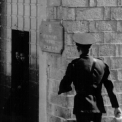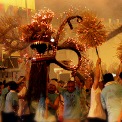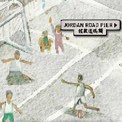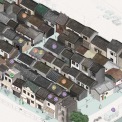-
History & Society
- Education in Pre-war Hong Kong
- History of Taikoo Sugar Refinery
- Hong Kong Products Exhibition
- Local Festivals Around the Year
- Post-war Industries
- Pre-war Industry
- The Hong Kong Jockey Club Archives
- Tin Hau Festival
- Memories We Share: Hong Kong in the 1960s and 1970s
- History in Miniature: The 150th Anniversary of Stamp Issuance in Hong Kong
- A Partnership with the People: KAAA and Post-war Agricultural Hong Kong
- The Oral Legacies (I) - Intangible Cultural Heritage of Hong Kong
- Hong Kong Currency
- Hong Kong, Benevolent City: Tung Wah and the Growth of Chinese Communities
- The Oral Legacies Series II: the Representative List of the Intangible Cultural Heritage of Hong Kong
- Braving the Storm: Hong Kong under Japanese Occupation
- A Century of Fashion: Hong Kong Cheongsam Story
Geography & EnvironmentArt & Culture- Calendar Posters of Kwan Wai-nung
- Festival of Hong Kong
- Ho Sau: Poetic Photography of Daily Life
- Hong Kong Cemetery
- Sketches by Kong Kai-ming
- The Culture of Bamboo Scaffolding
- The Legend of Silk and Wood: A Hong Kong Qin Story
- Journeys of Leung Ping Kwan
- From Soya Bean Milk To Pu'er Tea
- Applauding Hong Kong Pop Legend: Roman Tam
- 他 FASHION 傳奇 EDDIE LAU 她 IMAGE 百變 劉培基
- A Eulogy of Hong Kong Landscape in Painting: The Art of Huang Bore
- Imprint of the Heart: Artistic Journey of Huang Xinbo
- Porcelain and Painting
- A Voice for the Ages, a Master of his Art – A Tribute to Lam Kar Sing
- Memories of Renowned Lyricist: Richard Lam Chun Keung's Manuscripts
- Seal Carving in Lingnan
- Literary Giant - Jin Yong and Louis Cha
Communication & Media- Hong Kong Historical Postcards
- Shaw Brothers’ Movies
- Transcending Space and Time – Early Cinematic Experience of Hong Kong
- Remembrance of the Avant-Garde: Archival Camera Collection
- Down Memory Lane: Movie Theatres of the Olden Days
- 90 Years of Public Service Broadcasting in Hong Kong
- Multifarious Arrays of Weaponry in Hong Kong Cinema
-
History & SocietyGeography & EnvironmentArt & Culture
-
View Oral History RecordsFeatured StoriesAbout Hong Kong Voices
-
Hong Kong MemoryHong Kong CemeteryRecently Visited
User's Guide to Database
Entries
There are two types of entries in the database. The majority of the records are information of a deceased occupying an individual grave. Of the 6,888 records, 1,957 records are collective graves where more than one deceased are buried or their names are inscribed on the gravestone.
Categories applied in the database:
NameInscriptionPlotDate of deathAgeSexPlace of BirthRank (Regiment or Ship)Occupation (Employer)Cause of deathMonument (Description of the grave stone or monument)FeatureErected by
Notes to the CategoriesName
This is the name of the deceased buried in the grave or inscribed on the gravestone. In some records, readers may not be able to find consistency between the name and the inscription in the image or provided by the database. It is because either the name is inscribed on another face of the gravestone not included in the photo, or the author is able to find supplementary information from other sources. In around 60 records, the information of name is replaced by a statement saying that the record tells about the gravestone rather than the deceased under the stone. For names given in Chinese or Japanese, the field is specified by "[Chinese name]" or "[Japanese name]". Other languages not comprehensible by the author and those who take record of the information, the category Name is given as "[Name unknown]". When name is not found on the gravestone, Name is also given as "[Name unknown]".
InscriptionsThe information is an exact copy of the words engraved onto the stone. Often the older inscriptions are worn and difficult to read and the difficulties of deciphering the inscriptions are compounded where they are in for example Dutch, German or Scandinavian. Problems have occurred when collecting data from tombs whose inscriptions are in languages not known to those collecting and compiling the data. The authors would like to apologize in advance for the inevitable mistakes that have occurred and the sometimes garbled versions of the languages in question that may be present in the database. Characters or symbols bracketed with […] are those remarks made by the author, and should not be read as part of the original inscription on the headstone.When found on the tomb, the name of the undertaker/stone mason is given below the inscription as is the number under which the incumbent is entered in the burial register of St. John’s Cathedral. This number is preceded by the # sign.
In some cases, the end section of the inscriptions are truncated probably during the conversion of database files. For some records, the lost information can be recovered by cross-checking with the corresponding images; while the editors fail to do so as the images are not good enough. In the latter case, the editors remarked in the records with "[incomplete, can't see from the photo]".PlotUnder this category they are given a Section/Row/Number under the category ‘Plot.’ For example, Sir Robert Hotung’s entry is numbered Section 11B/Row 13/Number 2 and will appear under “Plot” as 11B/13/2. The numbering of the plots has been kept in accordance with the historical numbering on the maps of the Hong Kong Cemetery. Records bearing the same plot no. are co-occupants of the same grave, which are labelled as "family grave" or "collective gravestone" under the category "Feature".
The main map and individual maps for each section are organized under “Researchers’ Sketches” so that anyone wanting to find an individual grave should be able to locate it without too much trouble.Place of BirthThis category is basically composed of the town and country where the particular person was born. For some items, the category also indicates the nationality of that particular person. A foreign name and the use of a foreign language on the inscription have been used as pointers to nationality particularly where it is not stated on the inscription where that person was born. With the White Russian Community we have labeled individuals as Russian if they have Russian names and/or display a Russian Orthodox cross on their headstone irrespective of where they were born.Date of deathUnder the category ‘Date of Death’ the format is yyyy-mm-dd, so for example 1884-12-25 reads as December 25th, 1884. Since month and day need to be inputted, where the month and day of death cannot be read or only the year of death is shown on the tombstone, the month and day are given as 01-01. In these cases, the date will appear, for example, as 1884-01-01.ChildrenIf the age at death is under 1, the age is given as 0.To add to the usefulness of the database and distinguish between infants and children, if a child has survived infancy and is aged between 5 years and 16 years (inclusive), under the category ‘Employment,’ they are entered as a student. They may not necessarily have actually been attending school.EmploymentA number of people changed their type of employment during the course of their lives. For example, men arrived in the Colony as members of the army garrison, then left the army to become policemen and then, when they had amassed some capital, opened a tavern. The type of employment given is as far as is known the last one in their lives.Rank: Captains, Commanders, Fuhrers, etc. in the Merchant NavyUnder the category of ‘Rank’, in all cases where men are designated in charge of ships that are part of the merchant navy, they have been described as Master Mariners. This has been done to distinguish them from the military and naval ranks of Captain and Commander.FeatureA number of useful categories have been shown under the category ‘Feature’. These include the following:For tombs occupying the same plot, they are either marked as "family grave" or "collective gravestone". "Family grave" is used if the co-occupants bear the same family name or their familial association is described on the inscription; "Collective gravestone" is used if the names of more than one deceased are inscribed on the stone.
All tombs bearing a photograph of the deceased are entered “Photo”. The use of a photo denotes that the person responsible for the putting up the stone (usually the wife or close family) is almost certainly a Chinese as the placing of photos on headstones and monuments is a Chinese custom.All tombs with part or all of the inscription in Chinese script are shown “Chinese characters” under this category.All tombs with part or all of the inscription in Russian script are shown “Russian characters” under this category.All tombs showing the freemason symbol are entered “Freemason”. In some cases where it is known that the deceased is a freemason but no symbol is present on the headstone, it is shown here that “He is a freemason”.All tombs where the deceased is shown to have been awarded honours or medals are indicated “Honours and awards”. Sometimes honours are shown here that are not present on the headstone, if it is known that they were awarded to the deceased in question.Marker Stones (Paupers)In some areas, most notably section 6, there are a quantity of small granite marker stones bearing just the number of the burial record. For the most part these belong to paupers who were buried free of charge by the Government. Except in section 6 where the stones and their numbers have been noted, these marker stones are not recorded in the database. Users will find in section 6 some groups of records which have no information for name, inscription, etc. The image attached however gives users some sense of how this kind of "grave" looks like.Mistakes and anomaliesThe researchers have taken whatever care they could to make this database accurate and comprehensible. However in a database of this size, mistakes and anomalies are bound to occur. The authors would like to apologize in advance for the inevitable mistakes, omissions, typos and anomalies.Copyright © 2012 Hong Kong Memory. All rights reserved.









